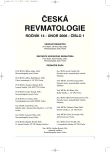Modulation of bone turnover by glucocorticoid treatment
Vliv terapie glukokortikoidy na kostní metabolismus
Osteoporóza je chronické hendikepující onemocnění, kterému pro jeho počáteční asymptomatickou fázi není věnována dostatečná pozornost laické ani odborné veřejnosti. Sekundární prevence této metabolické choroby není samozřejmostí ani v ambulancích specialistů a pouze jedna z pěti porotických zlomenin je léčena. Osteoporóza je mylně pokládána za nemoc pouze starší populace, ale podle statistiky International osteoporosis foundation (IOF) má osteoporózu jedna ze dvou žen a jeden z osmi mužů ve věku 50 let. U žen v tomto věku je mortalita na zlomeninu krčku kyčelního kloubu stejná jako u karcinomu prsu. Je třeba zmínit i ekonomické důsledky. Při prevalenci osteoporózy v České republice, která činí 750 tisíc nemocných, se jen na farmakoterapii osteoporózy vynakládá ročně přibližně 7,5 miliard korun a další podobná částka plyne na operace porotických fraktur a perioperační období. Všechny výše uvedené statistiky je třeba při trendu stárnutí populace považovat za alarmující. Glukokortikoidy navozená ztráta kosti je pro široké terapeutické užívání těchto steroidů nejčastější sekundární osteoporózou. Podle posledních studií neexistuje bezpečná dávka glukokortikoidů, při níž nehrozí nebezpečí vedlejších účinků. Autoři tohoto článku se věnují patogenetickým mechanismům glukokortikoidy indukované osteoporózy. V závěru článku je nastíněna problematika, kterou bude třeba v budoucnosti podrobit intenzivnímu výzkumu. Odborné společnosti pak prostřednictvím svých doporučení a guidelines lépe prosadí účelnou prevenci a cílenou terapii, což považujeme za základní podmínku získání kontroly nad glukokortikoidy indukovanou osteoporózou – chorobou s vysokou morbiditou, častou sociální izolací pacientů a v neposlední řadě obrovskými ekonomickými důsledky.
Klíčová slova:
osteoporóza, glukokortikoidy, osteoblasty
Authors:
M. Scheinost; K. Pavelka
Authors‘ workplace:
Revmatologický ústav Praha
Published in:
Čes. Revmatol., 14, 2006, No. 1, p. 9-16.
Category:
Overview Reports
Overview
Osteoporosis is a chronic disabling disease, which, due to its asymptomatic onset, is frequently initially neglected. Secondary prevention of this metabolic disorder is not even common in the outpatient offices of specialists. Only one from five osteoporotic fractures is treated. Osteoporosis is misinterpreted as a disease of elderly but according to statistical data from the International osteoporosis foundation (IOF), one of two women and one of eight men 50 years old suffer from osteoporosis. Femoral neck fracture mortality in these women is similar to the breast cancer patients. It is necessary to mention economic aspects as well. While the prevalence of osteoporosis in the Czech Republic is 750 thousands patients, the pharmacotherapy costs approximate 7.5 billion Czech crowns per year and similar sum is spent for surgical managements and peri-operative period of osteoporotic fractures. All abovementioned statistics are alarming, particularly given the fact that population tends to be older. Glucocorticoid-induced loss of bone is the most frequent secondary osteoporosis owing to their widespread use. According to the recent studies, there is no safe dose of glucocorticoids that can avoid adverse events. The authors discuss here pathogenetic mechanisms of glucocorticoid-induced osteoporosis. An issue that is going to be under close scientific investigation in the near future is outlined at the end of this article. Then, particular guidelines postulated by professional associations could enforce rational prevention and specific treatment that are considered to control glucocorticoid-induced osteoporosis – the disease with high morbidity, common social isolation of the patients, and, last but not least, astronomical economic consequences.
Key words:
osteoporosis, glucocorticoids, osteoblasts
Labels
Dermatology & STDs Paediatric rheumatology RheumatologyArticle was published in
Czech Rheumatology

2006 Issue 1
Most read in this issue
- Diffuse idiopathic skeletal hyperostosis (DISH) and ossification of posterior longitudinal ligament (OPLL) - metabolic and genetic factors
- Uncommon coincidence of Charcot osteoarthropathy with enteropathic arthritis
- The significance of Borrelia burgdorferi DNA investigation in a diagnostic algorithm of Lyme arthritis
- Modulation of bone turnover by glucocorticoid treatment
